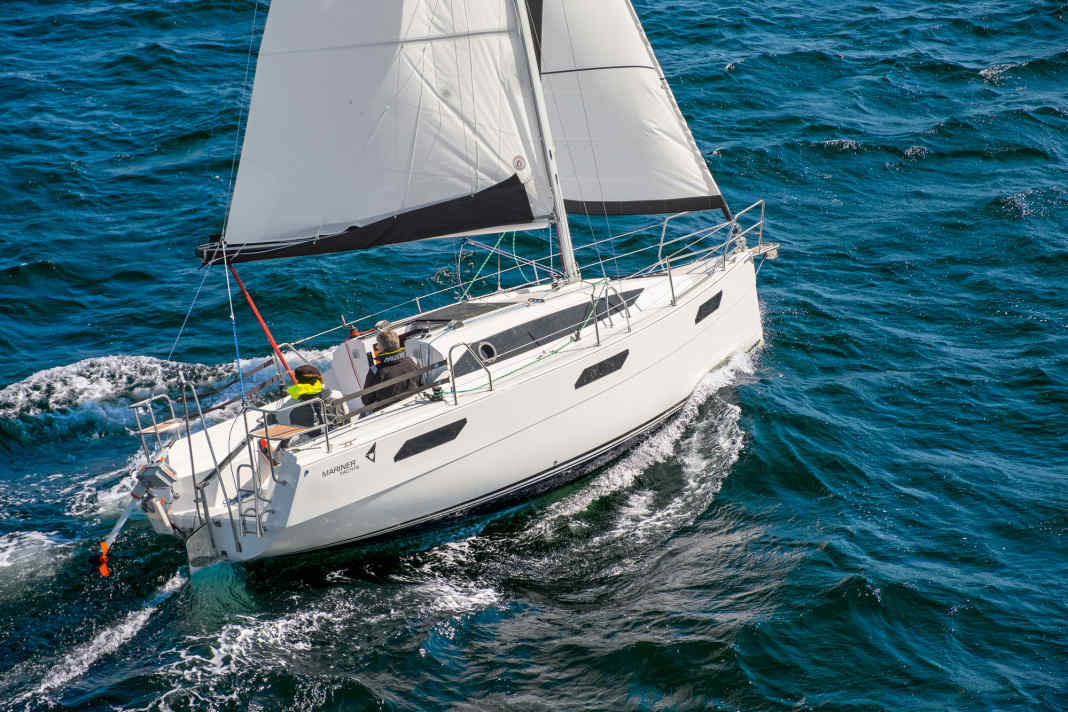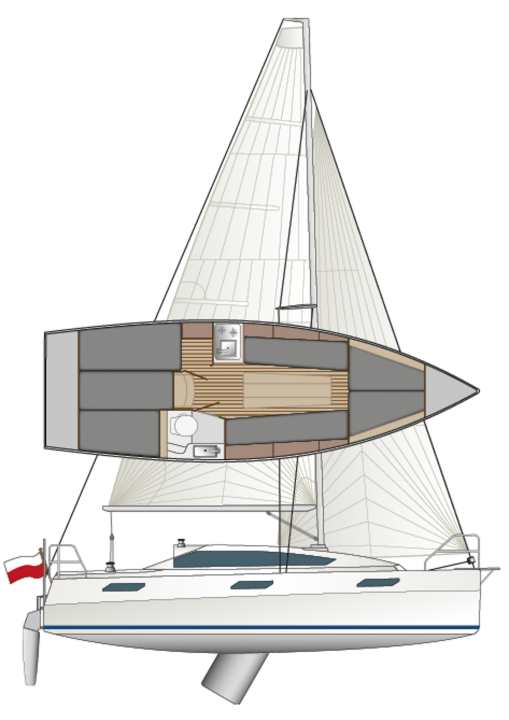





During the test in Neustadt on the Bay of Lübeck, the wind is blowing strongly at 16 knots. In gusts, of which there are many with only short breaks, the wind speed rises to 30 knots, i.e. 7 Beaufort - not ideal test conditions for a 26-foot boat. But the wind is blowing offshore, so no waves have built up.
However, the casting off manoeuvre is the first test: with a Torqeedo Travel electric motor, the Mariner 26 is underpowered for its two tonnes of weight. With a strong crosswind, it is impossible to turn the bow against the wind when leaving the box; the freeboard, which is a good metre high, offers the wind too much surface to attack. However, manoeuvring backwards out of the pit lane is slow and controlled. As soon as more manoeuvring space is available, the bow can also be turned through the wind with sufficient momentum.
The competition of the Mariner 26
After setting the mainsail, this effect is repeated: the Mariner must have enough speed to be able to drop onto a rough course. Simply raising the sheet and putting the rudder down at low speed does nothing, the hull remains at right angles to the wind; the lateral drift means there is no flow around the rudder and folding keel.
In addition, the new boat, which is sailing for the first time for the test, still lacks reefing lines. The sail area of the mainsail is too large in relation to the genoa, which is only half unfurled. In gusts, there is no other option but to heavily furl the mainsheet. Nevertheless, in particularly strong gusts, the sun sometimes shoots out.
Travelling fast with the Mariner
Otherwise, the Mariner steers very well in view of the marginal conditions. All manoeuvres are smooth and controlled, and there is at least no lack of boat speed in the tacks. At 4.5 to 5.0 knots, the boat makes rapid progress. The maximum height upwind cannot be determined. Due to the lack of reefing lines, a schrick in the sheet is essential to maintain control. The smallest angle to the wind is therefore reached at around 55 degrees. However, this still allows us to make up distance to windward, which we try out straight away in view of the low motorisation. The way back towards the harbour is no problem, so we head back out into the bay on a beam reach course. Speeds of 6.5 to just under 7 knots over the ground are possible - a very good figure for a 26-foot boat, but not entirely surprising given the strong wind.
We don't get into planing with the Mariner 26. More surprising are the courses and speeds higher upwind, which show the small yacht to be a seaworthy boat - although it is expressly designated for coastal areas. The Mariner is not a boat for venturing to Bornholm in 30 knots of wind, for example; the voluminous hull with a relatively high centre of gravity due to the internal ballast is not designed for this. The fact that the boat still shows good sailing characteristics in the prevailing conditions is therefore all the more pleasing. However, with the waves typical of 30 knots of wind, things could look very different again; it is sheltered in Neustadt Bay and the waves are barely 20 centimetres high.
Command centre
The cockpit layout is ideal for two sailors. The 1.90 metre long cockpit thwarts are comfortable to sit on when there is plenty of room. Thanks to the relatively narrow width of 1.66 metres, you can simply rest your feet on the opposite bulwark. When the boat is less level, the helmsman and foresailor also sit very comfortably on the coaming; straps instead of the railing wires then allow pain-free leaning.
The tiller and mainsheet are within easy reach of the helmsman. The outboard motor can also be used to assist with harbour manoeuvres. The open stern and the tapered seat lines towards the stern make it easier to handle the engine and tiller.
The mainsheet block with clamp sits raised on a stainless steel bracket. A few times the sheet block jammed with the shackle in the fastening eye on the metal bracket. This caused the block to lean even under load and the sheet generated too much friction. A spring that holds the block upright could help.
In front of the seating position on the companionway bulkhead, foresheet winches and the halyards and outhauls on the superstructure, which are deflected aft, are within easy reach. The keel can also be raised here using the winch.
Exciting segment
With its 7.68 metre hull, the Mariner 26 is somewhere between a small cruiser and a large cruiser. Its maximum width of 2.55 metres makes it trailerable, yet there is a separate aft cabin and a toilet room below deck, which immediately gives you the feeling of being on a large ship. She is also very stable in the water despite her folding keel, which makes her feel safe even when moored in the harbour.
The size is attractive for small crews or families with children, thanks to trailerability, changing areas is no problem and winter storage costs can be eliminated if a private parking space is available. Nevertheless, with four full berths (plus the saloon benches), galley and bathroom, the Mariner offers everything you need for longer cruises. A folding keel with more ballast for coastal cruising (extra charge) and a fixed keel (extra charge) are available as options. The options list also includes wheel steering (extra charge).
There is some competition for the Mariner in this size segment. The Maxus 26 has the most in common. However, it is too wide for easy trailering. The Storm 26 appeals more to a group of buyers who want to sail sportily, and it is significantly more expensive. The Sunbeam has been on the market for a long time and is now available in the 26.2 version. It has a slightly longer hull, but is narrower and offers nowhere near as much volume. It can also be ordered with a variable draught. In terms of finances, however, it plays in a different league to the Mariner.
Internal values of the Mariner 26
The space below deck is generous, and the almost one-and-a-half metre long superstructure windows and the hull windows allow plenty of light into the saloon and foredeck. The latter can also be separated from the saloon by a sliding door (extra charge). The saloon benches and berths are part of the inner shell, but this is only visible under the cushions or in the wet room. The woodwork is very well done and of high quality. The edge finishes are made of one-millimetre-thick veneer and not just wafer-thin plastic film, which is very pleasing. The side walls are covered with a velour lining. This looks good and also contributes to comfort in the aft cabin, as you can lean comfortably against the side of the boat. This means that the berth can be used for more than just upholstery, or you can sit leaning against the side of the boat and read or watch a film on your tablet.
It is also nice that the hull windows are then at a favourable height for looking out. This also applies to the hull windows in the saloon.
The saloon benches are cosy thanks to a half-height backrest. On the starboard side, it is also long enough to stretch out, but at 67 centimetres it is too narrow for sleeping. For an additional charge, the saloon benches can be widened. The backrest also limits the space at the top. The port bench is shortened by the pantry block and measures 1.83 metres in length. At the front, there is a backrest that separates the bench from the foredeck like a seating area (surcharge).
The aft cabin, which is separated by a door, is also an extra at the expense of the galley size. With the aft cabin open, it has more space. The galley block in the two-cabin version comprises a very compact arrangement of a cooker with two burners, a sink, refrigerator compartment and a locker. When opened, the cooker and sink cover is a practical splash guard for the saloon bench and when closed, it is the only work surface. However, the saloon table is not far away either, offering plenty of space when folded out at 56 x 136 centimetres.
As much living space as there is below deck, the stowage capacity is limited. In addition to the narrow shelving area, there are only two compartments under the bunk cushions in the foredeck; however, a travelling bag does not fit in them. The same applies to the two stowage compartments per saloon bench. Instead, there are two lockable lockers on each side of the saloon, but these will probably be more or less filled with crockery, as the galley has no space for this. The aft cabin also only has two slightly larger compartments, under the berth and under the seat next to the door. Neither is big enough for a travelling bag. There are two lockers on the starboard side of the cockpit, but they are quite shallow so as not to restrict the aft compartment too much.
In theory, there would be berths for four adults and two children. However, there is no storage space for small luggage per person. It is nice that the toilet room and aft cabin can be ventilated via a small porthole in addition to permanent ventilation. However, there are no ventilation options above the galley block.
The Mariner 26 with folding keel is certified to CE category C, with a fixed keel to B. However, the boat is then also 250 kilograms heavier, as only half the internal ballast is installed, but 500 kilograms of keel are added.
Lots of choice
However, the variety for the drives is even greater than for the attachments. There are four options to choose from. The cheapest is a Torqeedo outboard motor. The Yamaha outboard motor is slightly more expensive, but more powerful at 8 hp. A built-in diesel is also feasible, but it takes up a lot of space in the interior and costs extra. Even the Torqeedo pod drive would be cheaper; it would be more space-saving anyway.
Such extras can quickly almost double the basic price. However, if you hold back a little on the extras, the Mariner 26 is a very fair offer.
The measured values for the test of the Mariner 26




The Mariner 26 in detail

Technical data of the Mariner 26
- Designer:Mariner
- CE design category:C
- Torso length:7,68 m
- Width:2,55 m
- Draught/catch-up:1,45/0,33 m
- Weight:2,0 t
- Ballast/proportion:0,58 t/29 %
- Mainsail:17,60 m2
- Furling genoa (110 %):12,90 m2
- Drive (Torqeedo):2.2 kW/3 hp
Hull and deck construction
- Hull: Solid polyester laminate with inner shell
- Deck: Sandwich with foam core
Price
- Base price ex shipyard: 42.490 €
- Guarantee/against osmosis: 2/2 years
As of 10/2023, how the prices shown are defined can be found here !
Shipyard
Mariner Yachts Poland; www.mariner.pl
Distribution
Yachthandel Hamburg; www.yachthandel-hamburg.de
YACHT review of the Mariner 26
The Mariner 26 impresses with good sailing characteristics and a nave-like interior with plenty of space. The woodwork in dark-stained oak is well done. The price is fair.
Design and concept
- + Plenty of space below deck
- + Trailer bar without special licence
- - Quite high-sided
Sailing performance and trim
- + Decent sailing performance
- + Well-placed fittings
Living and finishing quality
- + Clean woodwork
- + Very large aft berth
- - Little storage space
Equipment and technology
- + Well integrated jogging device
- + All lines redirected to the cockpit
- - Small baking boxes
This article first appeared in YACHT 12/2020 and has been updated for this online version.

